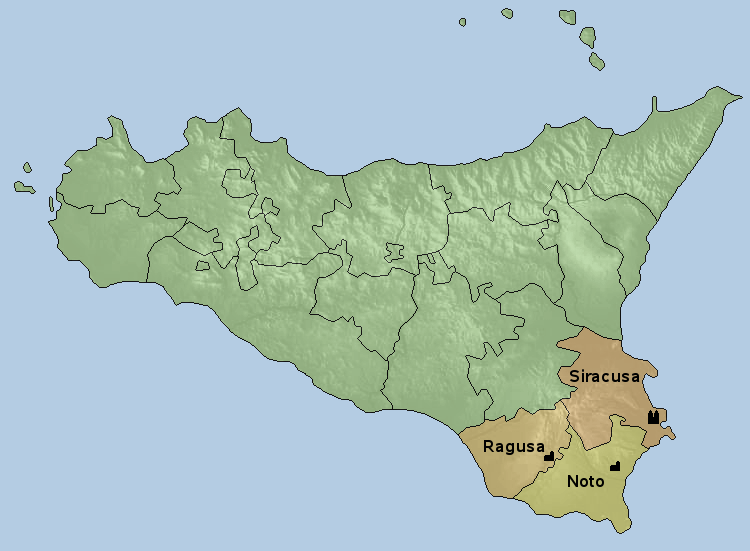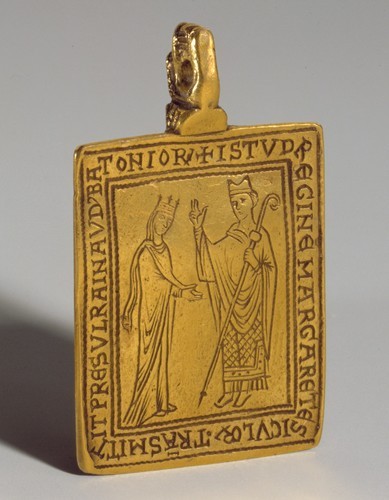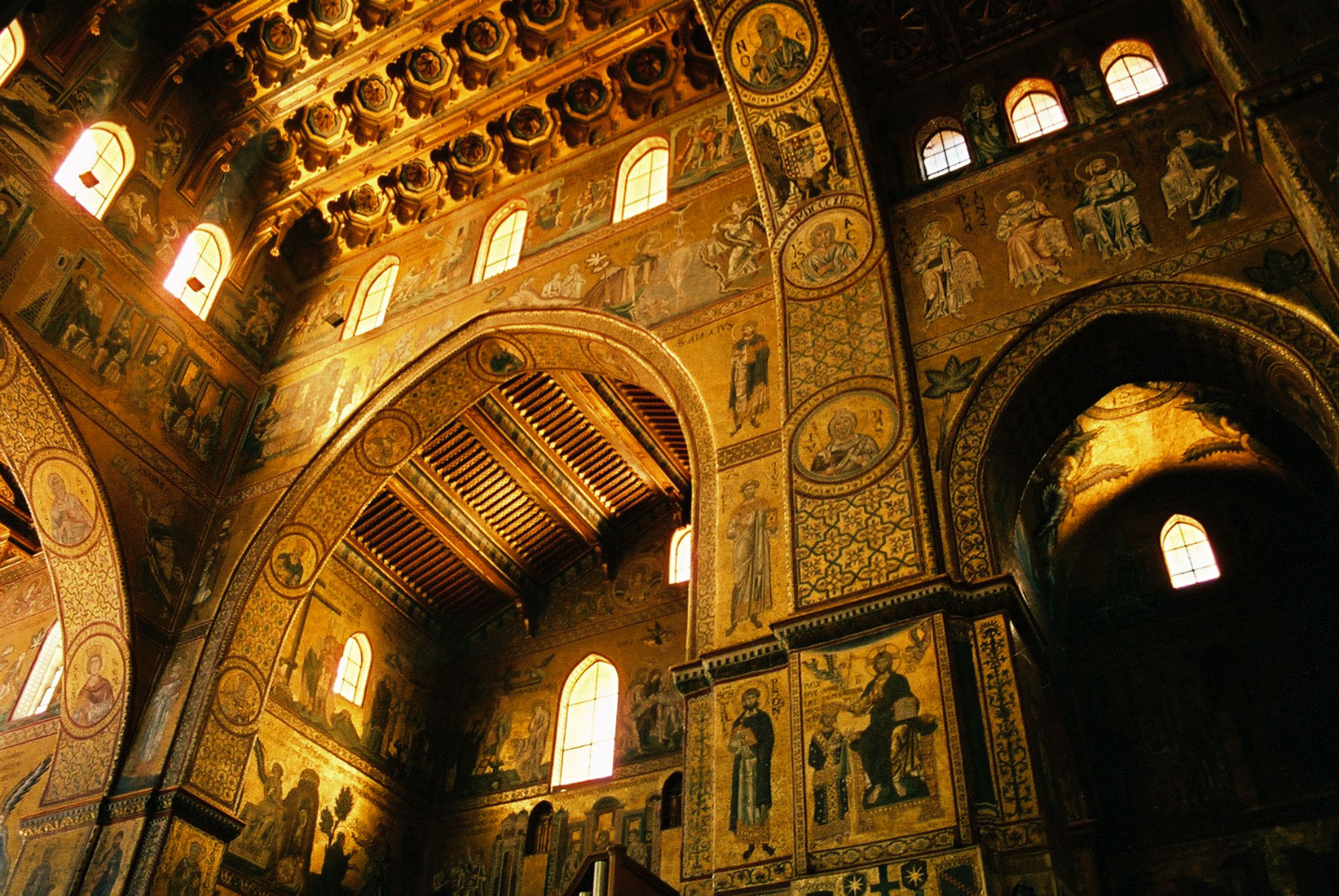|
Richard Palmer (archbishop)
Richard Palmer, an Englishman, was the bishop of Syracuse from 1169 and archbishop of Messina from 1182. Palmer first rose to prominence in 1160 as one of the triumvirate of grandees who replaced the assassinated Admiral Maio of Bari. He was "a man of great learning and eloquence," according to Hugo Falcandus. On the death of Bishop Rinaldo de Lusio in 1154, Palmer was elected bishop of Syracuse, but he was not consecrated until 1169. On Saturday 11 March 1161, he joined with three other great ecclesiastics of the kingdom—Romuald, Archbishop of Salerno; Robert, Archbishop of Messina; and Tristan, Bishop of Mazara—to incite the people of Palermo to rise against the rebels led by Matthew Bonnellus and free the royal family. In 1162, Sylvester of Marsico died and Henry Aristippus was disgraced, thus Palmer was the only member of the original triumvirate left in power. The replacements, Matthew of Ajello and the caïd Peter, remained in power until the death of King Wi ... [...More Info...] [...Related Items...] OR: [Wikipedia] [Google] [Baidu] |
Bishop Of Syracuse
The Archdiocese of Siracusa, also known as Syracuse, ( la, Archidioecesis Syracusana) is a Latin Church ecclesiastical territory or diocese of the Catholic Church in Sicily. It became an archdiocese in 1844."Archdiocese of Siracusa" ''''. David M. Cheney. Retrieved February 29, 2016."Metropolitan Archdiocese of Siracusa" ''GCatholic.org''. Gabriel Chow. Retrieved February 29, 2016. The current archbishop is Francesco Lomanto. History |
Margaret Of Navarre
Margaret of Navarre (french: Marguerite, es, Margarita, it, Margherita) (c. 1135 – 12 August 1183) was Queen of Sicily as the wife of William I (1154–1166) and the regent during the minority of her son, William II. Queen consort Margaret was the daughter of King García Ramírez of Navarre and Marguerite de l'Aigle. She was married at a young age to William I of Sicily, in 1149, the fourth son of Roger II of Sicily. According to the Palermitan archivist Isidoro La Lumia, she was, in her later years, ''bella ancora, superba, leggiera'' ("still beautiful, proud, light"). During the reign of her husband, Margaret was largely ignored by William who spent much of his time away from court - often frequenting his many personal harems. However, she is considered to have been a stronger, more apt administrator than her husband, and several times convinced him to act where he was determined to be passive. She worked closely with Maio of Bari, the king's '' ammiratus ammiratorum'', ... [...More Info...] [...Related Items...] OR: [Wikipedia] [Google] [Baidu] |
Louis VII Of France
Louis VII (1120 – 18 September 1180), called the Younger, or the Young (french: link=no, le Jeune), was King of the Franks from 1137 to 1180. He was the son and successor of King Louis VI (hence the epithet "the Young") and married Duchess Eleanor of Aquitaine, one of the wealthiest and most powerful women in western Europe. The marriage temporarily extended the Capetian lands to the Pyrenees. During his march, as part of the Second Crusade in 1147, Louis stayed at the court of King Géza II of Hungary on the way to Jerusalem. During his stay in the Holy Land disagreements with his wife led to a deterioration in their marriage. She persuaded him to stay in Antioch but Louis instead wanted to fulfil his vows of pilgrimage to Jerusalem. He was later involved in the failed siege of Damascus and eventually returned to France in 1149. Louis' reign saw the founding of the University of Paris. He and his counsellor Abbot Suger, pushed for greater centralisation of the state and fa ... [...More Info...] [...Related Items...] OR: [Wikipedia] [Google] [Baidu] |
William II Of Sicily
William II (December 115311 November 1189), called the Good, was king of Sicily from 1166 to 1189. From surviving sources William's character is indistinct. Lacking in military enterprise, secluded and pleasure-loving, he seldom emerged from his palace life at Palermo. Yet his reign is marked by an ambitious foreign policy and a vigorous diplomacy. Champion of the papacy and in secret league with the Lombard cities, he was able to defy the common enemy, Frederick Barbarossa. In the ''Divine Comedy'', Dante places William II in Paradise. He is also referred to in Boccaccio's ''Decameron'' (tale IV.4, where he reportedly has two children, and tale V.7). William was nicknamed "the Good" only in the decades following his death. It is due less to his character than to the cessation of the internal troubles that plagued his father's reign and the wars that erupted under his successor. Under the Staufer dynasty his reign was characterised as a golden age of peace and justice. His numer ... [...More Info...] [...Related Items...] OR: [Wikipedia] [Google] [Baidu] |
Thomas Becket
Thomas Becket (), also known as Saint Thomas of Canterbury, Thomas of London and later Thomas à Becket (21 December 1119 or 1120 – 29 December 1170), was an English nobleman who served as Lord Chancellor from 1155 to 1162, and then notably as Archbishop of Canterbury from 1162 until his murder in 1170. He is venerated as a saint and martyr by the Catholic Church and the Anglican Communion. He engaged in conflict with Henry II, King of England, over the rights and privileges of the Church and was murdered by followers of the king in Canterbury Cathedral. Soon after his death, he was canonised by Pope Alexander III. Sources The main sources for the life of Becket are a number of biographies written by contemporaries. A few of these documents are by unknown writers, although traditional historiography has given them names. The known biographers are John of Salisbury, Edward Grim, Benedict of Peterborough, William of Canterbury, William fitzStephen, Guernes of Pont-Sa ... [...More Info...] [...Related Items...] OR: [Wikipedia] [Google] [Baidu] |
Pope Alexander III
Pope Alexander III (c. 1100/1105 – 30 August 1181), born Roland ( it, Rolando), was head of the Catholic Church and ruler of the Papal States from 7 September 1159 until his death in 1181. A native of Siena, Alexander became pope after a contested election, but had to spend much of his pontificate outside Rome while several rivals, supported by Holy Roman Emperor Frederick I Barbarossa, claimed the papacy. Alexander rejected Byzantine Emperor Manuel I Komnenos' offer to end the East–West Schism, sanctioned the Northern Crusades, and held the Third Council of the Lateran. The city of Alessandria in Piedmont is named after him. Early life and career Rolando was born in Siena. From the 14th century, he was referred to as a member of the aristocratic family of Bandinelli, although this has not been proven. He was long thought to be the 12th-century canon lawyer and theologian Master Roland of Bologna, who composed the "Stroma" or "Summa Rolandi"—one of the earliest comment ... [...More Info...] [...Related Items...] OR: [Wikipedia] [Google] [Baidu] |
Walter Of The Mill
Walter Ophamil or Offamil ( fl. 1160–1191), italianised as Gualtiero Offamiglio or Offamilio from Latin ''Ophamilius'', was the archdeacon of Cefalù, dean of Agrigento, and archbishop of Palermo (1168–1191), called "''il primo ministro''", the first minister of the crown. He came to Sicily with Peter of Blois and Stephen du Perche at the direction of Rotrou, Archbishop of Rouen, cousin of Queen Margaret of Navarre, originally as a tutor to the royal children of William I of Sicily and Margaret. His mother was Bona, a patron of the Abbey of Cluny and a ''devota et fidelis nostra'' of the king in 1172. His father is unknown. From his name he was long thought to be an Englishman ("Walter of the Mill") but this interpretation is now rejected in favour of ''ophamilius'' referring to Walter as William II's ''protofamiliaris'', the senior confidant of the king in his royal household, the '' familiaris regis''. Biography Walter's first appearance in the historical record ... [...More Info...] [...Related Items...] OR: [Wikipedia] [Google] [Baidu] |
Richard Of Molise
Richard of Mandra (died ca. 1170) was a Norman nobleman in the Kingdom of Sicily appointed count of Molise and chancellor by the queen regent Margaret of Navarre. Richard was son of Hugues II, Count of Molise and Clemenza, an illegitimate daughter of Roger II of Sicily. In 1157, as the constable of Robert II of Bassunvilla, he was captured by King William I. He joined the conspiracy of Matthew Bonnellus in 1161, but when Simon of Taranto and Tancred of Lecce assaulted the palace and William was arrested, Richard put his body between certain especially violent knights and saved the king's life. For this, he was rewarded when the rebellion collapsed. On William's death in 1166, the queen, Margaret, took up the regency for the young William II. She gave him the old and important county of Molise and the chancellery because she trusted his loyalty to the royal family. In 1167, he was accused of having an affair with the queen, who was clearly infatuated with him. However, these clai ... [...More Info...] [...Related Items...] OR: [Wikipedia] [Google] [Baidu] |
Caïd Richard
Richard the Qaid () was a senior official ('' qāʾid'', commander) of the royal council ('' curia regis'' or '' diwan'') in the court of the Norman Kingdom of Sicily at Palermo during the latter years of the reign of William I of Sicily and during the regency of his wife, Margaret of Navarre, for their son William II. He was already the Great Chamberlain, or ''magister camerarius'', when William I died in 1166. Origin Richard was a Muslim convert to Christianity, and likely a eunuch. He possibly appears in the records of the royal council in January 1161, but he rose to prominence in the political affairs of the day only in 1166. Career during the regency for William II Appointment as master chamberlain and ''familiaris regis'' In that year, King William I died on 17 May, leaving his underage son William II on the throne, under the regency of the Queen-mother, and advised by a council of three ''familiares regis'' under the leadership of Peter the Qaid. Although in effective cont ... [...More Info...] [...Related Items...] OR: [Wikipedia] [Google] [Baidu] |
Henry, Count Of Montescaglioso
Henry (before 1144–1173×77), born Rodrigo according to Hugo Falcandus, was an alleged son of the Navarrese king García Ramírez and his wife, Margaret of L'Aigle, and brother of the Sicilian queen dowager Margaret, who made him Count of Montescaglioso (1166) and then Count of the Principate (1168). Arrival in Sicily (1166) The main primary source for Henry's life is the Sicilian court chronicler known as Hugo Falcandus. He is an extremely unfriendly source to Henry. He reports the rumour that Henry was never acknowledged as a son by the Navarrese king and was considered a bastard, the product of one of the queen's affairs.Hubert Houben, "Enrico di Navarra", Dizionario Biografico degli Italiani', Vol. 42 (1993). This is contradicted by the actions of his sister, who always treated him as a full brother of royal blood.John Julius Norwich, ''The Kingdom in the Sun, 1130–1194'' (London: Longmans, 1970). Henry's birth name, also, is evidence of legitimacy, for he was probably ... [...More Info...] [...Related Items...] OR: [Wikipedia] [Google] [Baidu] |
Stephen Du Perche
Stephen du Perche (1137 or 1138 – 1169) was the chancellor of the Kingdom of Sicily (1166–68) and Archbishop of Palermo (1167–68) during the early regency of his cousin, the queen dowager Margaret of Navarre (1166–71). Stephen is described by the contemporary chronicler Hugo Falcandus as "a son of the count of Perche", Rotrou III. He was a young man when he entered politics, born at the earliest in 1137 or 1138. He may have been named after King Stephen of England, at the time ruling the Duchy of Normandy. Arrival in Italy In 1166, Margaret appealed to her other cousin, Rotrou, Archbishop of Rouen, to send her a family member to aid and support her in government. Coincidentally, Stephen was at that moment preparing to go on crusade to the Holy Land and so decided to visit Palermo, the capital of Sicily, for a few months. There he ended up staying for two years. He was very young at the time, described as ''puer'' and ''adolescens'' by William of Tyre, and may have ... [...More Info...] [...Related Items...] OR: [Wikipedia] [Google] [Baidu] |




.jpg)